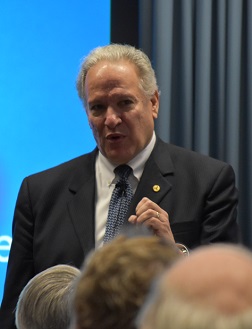Traveling the Road to Zero Vehicle Fatalities
If a 747 jumbo jet crashed anywhere in America, it would be in the national news for months.
Yet in 2015, there were 35,092 lives lost on America’s roads—equivalent to a 747 crashing every week for a whole year.
“We would not tolerate that—and yet we accept this as the lives lost on our [roadways],” said Mark Rosekind, administrator of the National Highway Traffic Safety Administration (NHTSA) and the final speaker in Volpe’s Future of Transportation series.
The challenge now is for society to say, “That is not acceptable,” Rosekind said.
“Why it’s a crisis now is because that number in 2015 went up by 7.2 percent,” he said. “When you look at that as a percentage jump, that is the highest percentage increase in over 50 years.”
Not only are fatal crashes increasing, but nearly all of them are theoretically preventable. Lives lost on roads account for 95 percent of total transportation fatalities, and 94 percent of crashes are due to human choice or error.
Watch video highlights of Mark Rosekind's talk at Volpe.
Three Lanes on the Road to Zero
1. Proactive Vehicle Safety
If you’ve shopped for a car over the past 40 years, you might be familiar with NHTSA’s five-star rating new car assessment program. Now, NHTSA is considering adding evaluations of innovative technologies and pedestrian protection to that program, Rosekind said.
“About 96 percent of all vehicles out there now get 4 or 5 stars,” Rosekind said. “So we have to get them differentiating again, set the bar higher.”
NHTSA is also advocating for automatic emergency braking (AEB) technology, which can detect a potential forward collision and apply brakes if the driver does not. In September 2015, NHTSA and the Insurance Institute for Highway Safety issued a challenge to automakers to make AEB standard in all vehicles.
Twenty automakers globally committed to making AEB standard by 2022, covering more than 99 percent of new vehicles, Rosekind said.
“If you want to democratize safety, it means you cannot have all this new technology only as an option, or only in the most expensive cars,” Rosekind said. “If you want to democratize safety, it’s got to be available to everybody.”
2. Better Communication About Highly Automated Vehicles
Crash avoidance is the epitome of proactive safety, and vehicle automation can help avoid crashes. Yet vehicle automation is not a monolithic term, Rosekind said. Automation is happening in stages, and at different levels.
Take level 3 automation: the driver still needs to be alert and ready to take over vehicle operation. But at level 5, the driver could take a nap, or tackle the Sunday crossword.
“People don’t really understand what’s here and what’s coming, and that’s one of the challenges,” Rosekind said. “One of the things we really need to do is start communicating and helping people understand [the different automation levels].”
3. Accounting for the Human Driver
There are a few common sense, good practice things that drivers can do to reduce road fatalities. They can drive sober, avoid distractions, and get plenty of rest before getting behind the wheel.
But there is sometimes a disconnect between what drivers know they shouldn’t do and what they actually do. NHTSA’s Road to Zero Coalition is focusing on proven strategies for reducing road fatalities, such as encouraging seatbelt use, installing rumble strips, launching behavior change campaigns, and conducting data-driven enforcement.
What’s missing, however, is a long-term vision plan, Rosekind said. To address that, NHTSA will begin working toward developing a 30-year plan for eliminating road fatalities.
“How do you wake up and have no lives lost on our roadways?” Rosekind said. “What would be the actions and milestones along that path to get us to zero? What’s exciting is you could be relatively new to being a safety professional, and you could wake up one morning and that’s the world you live in.”

NHTSA Administrator Mark Rosekind speaks to an audience at Volpe as part of the Future of Transportation series. (Volpe photo)
Opportunities to Save Lives
Plans and visions are important, but what matters is execution, Rosekind said. Over the last two years, NHTSA has been involved with a dozen significant road safety accomplishments. For the next dozen lifesaving initiatives, and the next dozen after that, the Road to Zero can act as an overarching, integrative concept, Rosekind said.
“I think we’re looking at probably the most significant change in safety on our roadways, forever,” Rosekind said. “And it’s not just about the technology; it’s about us acknowledging where we want to be as a society, not accepting these deaths and injuries on our roadways.”

